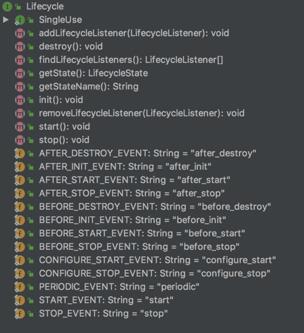深入浅出Tomcat/3 - Tomcat生命周期
Posted 江边闲话集
tags:
篇首语:本文由小常识网(cha138.com)小编为大家整理,主要介绍了深入浅出Tomcat/3 - Tomcat生命周期相关的知识,希望对你有一定的参考价值。
在上面的部分,其实我们已经接触到Tomcat的生命周期了,接下来我们将仔细讨论和学习Tomcat的生命周期的具体实现。
LifeCycle接口
这个LifeCycle接口上面在讲解Server和Service时其实已经有所接触。Tomcat通过org.apache.catalina.LifeCycle接口统一接管Tomcat的生命周期,所有继承自它的组件(即Component)都需要实现这个接口。
我们先俯视看一看LifeCycle接口的定义。

根据上图,我们清晰看到上图包含了4个生命周期的方法:
1. init
2. start
3. stop
4. destroy
这4个方法不用多解释,很直观,我们前面也有所接触。
同时,每个方法又定义了几个常量字符串,用于LifeCycleEvent事件的type属性,用来描述各个状态的变化。举个例子,对于init周期,它包含before_init和 after_init两个字符串,其他类似。
它同时也定义了三个管理监听器的方法,分别如下:
• addLifeCycleListener
• findLifeCycleListeners
• removeLifeCycleListener
显而易见,它们用来增加、查找和删除生命周期的监听器。
最后定义了获取当前状态信息,用2个方法实现:
• getState
• getStateName
getState返回的是LifeCycleState,而且LifeCycleState是一个枚举类型。如下
public enum LifecycleState { NEW(false, null), INITIALIZING(false, Lifecycle.BEFORE_INIT_EVENT), INITIALIZED(false, Lifecycle.AFTER_INIT_EVENT), STARTING_PREP(false, Lifecycle.BEFORE_START_EVENT), STARTING(true, Lifecycle.START_EVENT), STARTED(true, Lifecycle.AFTER_START_EVENT), STOPPING_PREP(true, Lifecycle.BEFORE_STOP_EVENT), STOPPING(false, Lifecycle.STOP_EVENT), STOPPED(false, Lifecycle.AFTER_STOP_EVENT), DESTROYING(false, Lifecycle.BEFORE_DESTROY_EVENT), DESTROYED(false, Lifecycle.AFTER_DESTROY_EVENT), FAILED(false, null);
我们看到它列举了Tomcat各个生命周期。
LifeCycleBase类
LifeCycleBase是实现了LifeCycle的抽象类,Tomcat的几个生命周期的管理都交给它,所以弄清楚这个类的实现,基本上也就明白了Tomcat的生命周期了。
在LifeCycle接口里,我们提到的4个周期的方法以及3个监听器的管理方法,最后还有2个获取状态信息的方法,我们接下来逐一分析和了解。
4个生命周期方法
方法init
public final synchronized void init() throws LifecycleException { if (!state.equals(LifecycleState.NEW)) { invalidTransition(Lifecycle.BEFORE_INIT_EVENT); } try { setStateInternal(LifecycleState.INITIALIZING, null, false); initInternal(); setStateInternal(LifecycleState.INITIALIZED, null, false); } catch (Throwable t) { handleSubClassException(t, "lifecycleBase.initFail", toString()); } }
先判断当前状态是不是NEW,如果不是抛出异常。因为init时,代表的是Tomcat的初始化,所以其状态需要为NEW的。接下来就是设置状态为LifecycleState.INITIALIZING,也就是正在初始化,然后调用initInternal开始初始化了,初始化完之后设置为LifecycleState.INITIALIZED
这里需要多说一下invalidTransition这个方法,因为后面很多地方都会用到它。
private void invalidTransition(String type) throws LifecycleException { String msg = sm.getString("lifecycleBase.invalidTransition", type, toString(), state); throw new LifecycleException(msg); }
我们看到invalidTransition方法其实没做其他事情,就是抛出了一个异常而已。
同时,也介绍一下setStateInternal这个方法,后面也用的较多。
private synchronized void setStateInternal(LifecycleState state, Object data, boolean check) throws LifecycleException { if (log.isDebugEnabled()) { log.debug(sm.getString("lifecycleBase.setState", this, state)); } if (check) { // Must have been triggered by one of the abstract methods (assume // code in this class is correct) // null is never a valid state if (state == null) { invalidTransition("null"); // Unreachable code - here to stop eclipse complaining about // a possible NPE further down the method return; } // Any method can transition to failed // startInternal() permits STARTING_PREP to STARTING // stopInternal() permits STOPPING_PREP to STOPPING and FAILED to // STOPPING if (!(state == LifecycleState.FAILED || (this.state == LifecycleState.STARTING_PREP && state == LifecycleState.STARTING) || (this.state == LifecycleState.STOPPING_PREP && state == LifecycleState.STOPPING) || (this.state == LifecycleState.FAILED && state == LifecycleState.STOPPING))) { // No other transition permitted invalidTransition(state.name()); } } this.state = state; String lifecycleEvent = state.getLifecycleEvent(); if (lifecycleEvent != null) { fireLifecycleEvent(lifecycleEvent, data); } }
变量check是传进来的,是否要检查。至于后面的逻辑注释写的比较清楚,不符合逻辑的状态转化都会报错,不多解释。
后面的fireLifeCycleEvent的代码如下:
protected void fireLifecycleEvent(String type, Object data) { LifecycleEvent event = new LifecycleEvent(this, type, data); for (LifecycleListener listener : lifecycleListeners) { listener.lifecycleEvent(event); } }
也是很简单,就是让LifeCycle的事件监听者触发事件,至于如何去使用这些event,则是每个监听者自己的业务逻辑了。这也符合一贯的代码实现方法,如果有多个监听器,然后逐一触发这些监听器,这其实是事件监听最基本的实现方法。
以上就是init的方法实现。
方法start
直接上代码
public final synchronized void start() throws LifecycleException { if (LifecycleState.STARTING_PREP.equals(state) || LifecycleState.STARTING.equals(state) || LifecycleState.STARTED.equals(state)) { if (log.isDebugEnabled()) { Exception e = new LifecycleException(); log.debug(sm.getString("lifecycleBase.alreadyStarted", toString()), e); } else if (log.isInfoEnabled()) { log.info(sm.getString("lifecycleBase.alreadyStarted", toString())); } return; } if (state.equals(LifecycleState.NEW)) { init(); } else if (state.equals(LifecycleState.FAILED)) { stop(); } else if (!state.equals(LifecycleState.INITIALIZED) && !state.equals(LifecycleState.STOPPED)) { invalidTransition(Lifecycle.BEFORE_START_EVENT); } try { setStateInternal(LifecycleState.STARTING_PREP, null, false); startInternal(); if (state.equals(LifecycleState.FAILED)) { // This is a \'controlled\' failure. The component put itself into the // FAILED state so call stop() to complete the clean-up. stop(); } else if (!state.equals(LifecycleState.STARTING)) { // Shouldn\'t be necessary but acts as a check that sub-classes are // doing what they are supposed to. invalidTransition(Lifecycle.AFTER_START_EVENT); } else { setStateInternal(LifecycleState.STARTED, null, false); } } catch (Throwable t) { // This is an \'uncontrolled\' failure so put the component into the // FAILED state and throw an exception. handleSubClassException(t, "lifecycleBase.startFail", toString()); } }
第一步就是检查状态的合理性,如果已经在准备或者开始了,直接抛出已经开始的exception。如果是NEW的话,说明init这一步没有做,那就初始化一下。
正式开始启动了,首先需要将状态设置为LifecycleState.STARTING_PREP,接下调用startInternal开始启动。执行完startInternal后验证state,如果状态不对,要么停止,要么抛出异常。
方法destroy
destroy其实调用的是stop方法。
方法stop
Stop方法
public final synchronized void stop() throws LifecycleException { if (LifecycleState.STOPPING_PREP.equals(state) || LifecycleState.STOPPING.equals(state) || LifecycleState.STOPPED.equals(state)) { if (log.isDebugEnabled()) { Exception e = new LifecycleException(); log.debug(sm.getString("lifecycleBase.alreadyStopped", toString()), e); } else if (log.isInfoEnabled()) { log.info(sm.getString("lifecycleBase.alreadyStopped", toString())); } return; } if (state.equals(LifecycleState.NEW)) { state = LifecycleState.STOPPED; return; } if (!state.equals(LifecycleState.STARTED) && !state.equals(LifecycleState.FAILED)) { invalidTransition(Lifecycle.BEFORE_STOP_EVENT); } try { if (state.equals(LifecycleState.FAILED)) { // Don\'t transition to STOPPING_PREP as that would briefly mark the // component as available but do ensure the BEFORE_STOP_EVENT is // fired fireLifecycleEvent(BEFORE_STOP_EVENT, null); } else { setStateInternal(LifecycleState.STOPPING_PREP, null, false); } stopInternal(); // Shouldn\'t be necessary but acts as a check that sub-classes are // doing what they are supposed to. if (!state.equals(LifecycleState.STOPPING) && !state.equals(LifecycleState.FAILED)) { invalidTransition(Lifecycle.AFTER_STOP_EVENT); } setStateInternal(LifecycleState.STOPPED, null, false); } catch (Throwable t) { handleSubClassException(t, "lifecycleBase.stopFail", toString()); } finally { if (this instanceof Lifecycle.SingleUse) { // Complete stop process first setStateInternal(LifecycleState.STOPPED, null, false); destroy(); } } }
首先,检查一下当前状态,如果当前状态为与STOP相关的几个状态,则抛出已经停止的异常。如果为NEW,说明还没有初始化,直接将STOPPED的状态赋值一下即可。如果状态不是STARTED,是不可以停止的,这个时候直接抛出异常。将触发的event给监听器和前面类似,不多做解释。
3个关于监听器的方法
前面介绍到LifeCycleBase有三个方法来管理监听器:
• addLifeCycleListener
• findLifeCycleListeners
• removeLifeCycleListener
我们看看它们的实现。
@Override public void addLifecycleListener(LifecycleListener listener) { lifecycleListeners.add(listener); } /** * {@inheritDoc} */ @Override public LifecycleListener[] findLifecycleListeners() { return lifecycleListeners.toArray(new LifecycleListener[0]); } /** * {@inheritDoc} */ @Override public void removeLifecycleListener(LifecycleListener listener) { lifecycleListeners.remove(listener); }
代码比较简单了,但是需要注意的是lifecycleListeners是一个CopyOnWriteArrayList。
private final List<LifecycleListener> lifecycleListeners = new CopyOnWriteArrayList<>();
关于CopyOnWriteArrayList,它继承了ArrayList。我们都知道ArrayList不是线程安全的,但CopyOnWriteArrayList则是线程安全的。
/** * Creates a list containing the elements of the specified * collection, in the order they are returned by the collection\'s * iterator. * * @param c the collection of initially held elements * @throws NullPointerException if the specified collection is null */ public CopyOnWriteArrayList(Collection<? extends E> c) { Object[] elements; if (c.getClass() == CopyOnWriteArrayList.class) elements = ((CopyOnWriteArrayList<?>)c).getArray(); else { elements = c.toArray(); // c.toArray might (incorrectly) not return Object[] (see 6260652) if (elements.getClass() != Object[].class) elements = Arrays.copyOf(elements, elements.length, Object[].class); } setArray(elements); }
我们可以看到代码行
elements = c.toArray();
它其实是Copy一份c,这种开销是很大的。尽管开销很大,但是当遍历操作的数量大大超过可变操作的数量时,这种方法可能比其他替代方法更有效。
同时,在add和remove时,我们看到使用到ReentrantLock来保证线程安全。
CopyOnWriteArray比较适用于读多修改少的情景。在Tomcat这里,一般来说Listener都是在Server.xml,如果在想增加或删除Listener,必须重新启动Tomcat,在这种场景下,其实正好符合读多写少这种特征。
public void add(int index, E element) { final ReentrantLock lock = this.lock; lock.lock(); try { Object[] elements = getArray(); int len = elements.length; if (index > len || index < 0) throw new IndexOutOfBoundsException("Index: "+index+ ", Size: "+len); Object[] newElements; int numMoved = len - index; if (numMoved == 0) newElements = Arrays.copyOf(elements, len + 1); else { newElements = new Object[len + 1]; System.arraycopy(elements, 0, newElements, 0, index); System.arraycopy(elements, index, newElements, index + 1, numMoved); } newElements[index] = element; setArray(newElements); } finally { lock.unlock(); } } /** * Removes the element at the specified position in this list. * Shifts any subsequent elements to the left (subtracts one from their * indices). Returns the element that was removed from the list. * * @throws IndexOutOfBoundsException {@inheritDoc} */ public E remove(int index) { final ReentrantLock lock = this.lock; lock.lock(); try { Object[] elements = getArray(); int len = elements.length; E oldValue = get(elements, index); int numMoved = len - index - 1; if (numMoved == 0) setArray(Arrays.copyOf(elements, len - 1)); else { Object[] newElements = new Object[len - 1]; System.arraycopy(elements, 0, newElements, 0, index); System.arraycopy(elements, index + 1, newElements, index, numMoved); setArray(newElements); } return oldValue; } finally { lock.unlock(); } }
获取状态
@Override public LifecycleState getState() { return state; } /** * {@inheritDoc} */ @Override public String getStateName() { return getState().toString(); }
代码非常简单,不介绍了。
以上是关于深入浅出Tomcat/3 - Tomcat生命周期的主要内容,如果未能解决你的问题,请参考以下文章